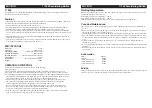
MICRON
T 1260 Desoldering Station
MICRON
T 1260 Desoldering Station
Working Temperature
When using solder of type 60% tin / 40% lead, (the most common solder used in electronics), we sug-
gest the temperature is set as follows:
Desoldering operation for small joint
320ºC
Desoldering operation for large joint
400ºC
(However it may take a little trial and error to achieve best results for your application.)
Care and Maintenance
1. Before use, always check the barrel locking nut is hand-tightened to ensure the tip is firmly held in
position.
2. To pro-long the life of your tip, tinning is necessary. To tin the tip, apply a small amount of solder to
the tip and then wipe off on the damp sponge.
The tips supplied are iron clad nickel with chrome plating and if used properly, will last a long time.
3. The solder catcher should be emptied of moltened solder when half full (or before half full) to allow
proper operation and maximum suction. Note, the steel wool filter must be installed for correct oper
ation.
4. If the desoldering tool is being used frequently, or on a production line, we suggest the filter is
cleaned once a week.
5. We also suggest that the tip cleaner is used to clean excess solder from inside the tip about every 100
operations.
6. Regularly remove the barrel and tip to keep it clean and clear of debris. This should be done at least
once a week.
Accessories.
Item
Part no.
Filter set
T 1263
1.0mm diameter tip
T 1264
1.2mm diameter tip
T 1265
1.5mm diameter tip
T 1266
Service
This desoldering tool does not contain any parts that require lubrication. For service and repairs please
contact your place of purchase. Warranty claims will require proof of purchase.
T 1260
Congratulations on purchasing the Micron T 1260 desoldering tool. Please read these instructions to
maximise the use and life of this unit.
Features
• Japanese-made ceramic heater, offering high isolation rated at over 100 Mohms at 400°C. (Heater life
is much longer than traditional Nichrome element wire heaters).
• PTC circuitry provides fast heat up and heat recovery.
• Electronic temperature controlled, analog display, with temperature range from 300°C to 450°C.
• High capacity suction vacuum pump makes the unit suitable for multilayer circuit boards.
• Zero voltage switching circuitry protects voltage and current sensitive components such as CMOS
devices against transient voltage spikes which can be caused by the heater element switching on and
off.
• Lightweight handle is easy to grasp and use. Handgrip does not heat up even after having been on
and used for a long period.
• Incorporates a temperature control lock to avoid unwanted temperature adjustment by the operator,
making the unit suitable for large production line use.
SPECIFICATIONS
Model No.
......................................................................T 1260
AC Input
..............................................................220-240V AC
Temperature Range
......................300°C -450°C (572-842°F)
Power Consumption
........................................45W at 350°C
Heating Element
................Japanese-made Ceramic Heater
Standard Tip
..................................................................1.0mm
Dimensions
..............................
≈
L170 x W120 x H105 (mm)
Weight
..............................................................................1000 g
OPERATION INSTRUCTIONS
1.
Insert the iron holder into the hole on the top of the housing.
2.
Moisten sponge.
3.
Connect silicon pipe to handle and base (if not already connected), and connect power cord.
4.
Turn power switch on (located on the left hand side lower part of base station), to "ON" position.
5.
Set the temperature knob to the desired setting. The heater “on” LED light will illuminate until the
tip reaches the desired temperature. When this light extinguishes desoldering can begin. Note this
light will continually switch on and off to keep the tip at the preset temperature.
6.
To desolder, place the bore of the desoldering tool tip over the solder join of component to be
removed and apply light pressure. Wait 1 -2 seconds until the solder melts, gently pull the
vacuum trigger switch and allow the pump to suck the molten solder away.
Note, to help melt the solder, slowly move the desoldering tool tip over the component lead.
Note it is very important to wait until the solder has melted. Failure to do so will result in poor
extraction of solder. This is especially so for plated through PCB’s.
7.
If solder remains, re-solder the component and then desolder again. (Note solder is the medium
used to transfer the heat necessary to remove all the solder)

















